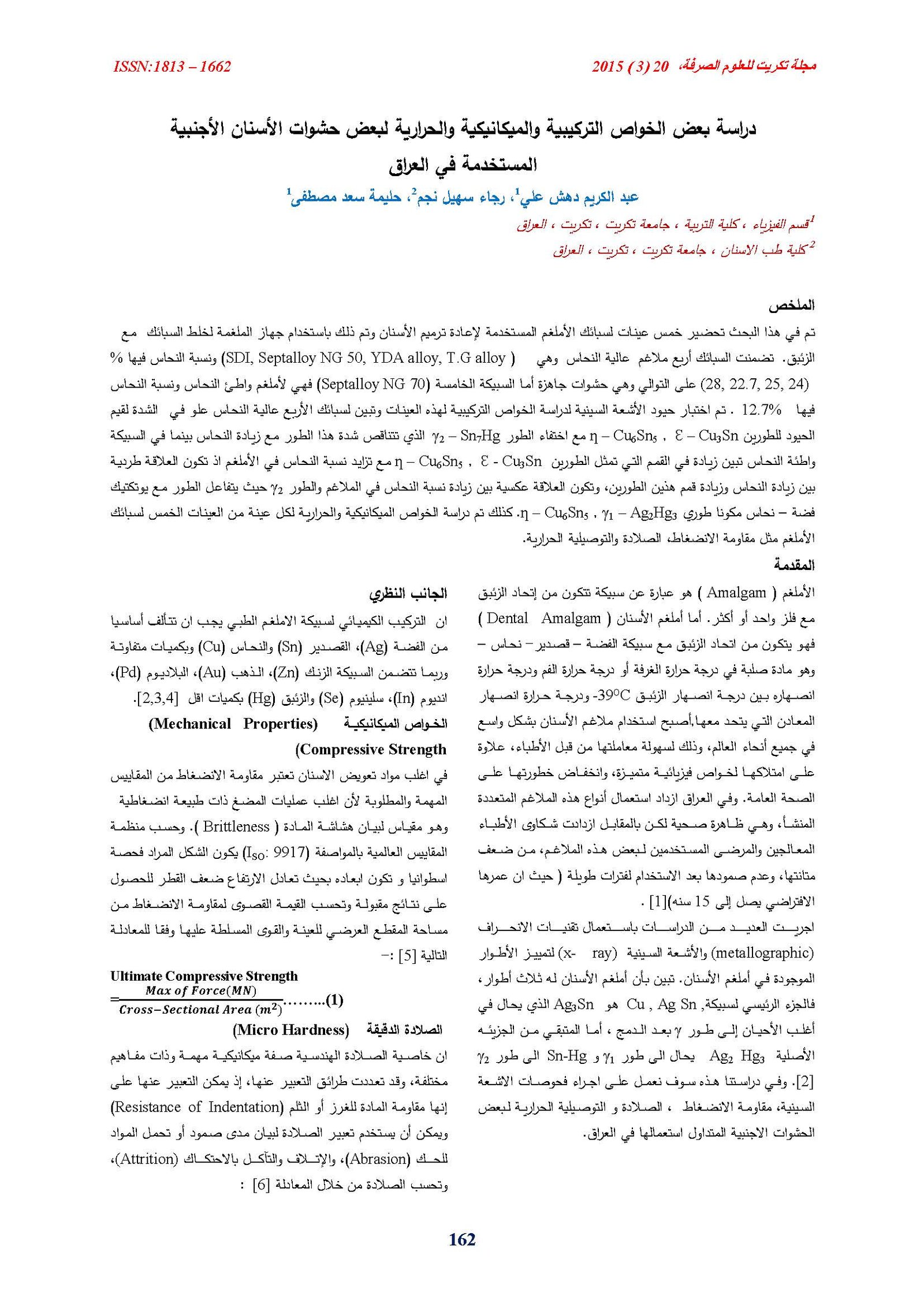Study of the thermal, mechanical and costrictional properties to some Foreign dental amalgams using in Iraq
Main Article Content
Abstract
In this paper, the preparation of five samples of amalgam alloy used for the restoration of teeth has been done using the amalgamation device for mixing alloys with mercury. The alloys included four high copper amalgams which are (SDI, Septalloy NG 50, YDA alloy, TG alloy) and the percentage of copper (28, 22.7 , 25, 24) % respectively, which are ready fillings. While the fifth alloy (Septalloy NG70) is for low copper amalgam with Copper ratio of 12.7%. The X-ray diffraction has been tested to study the structural properties of these samples and found for the four high-copper alloys increment in the intensity for the diffraction values of the two phases Ɛ - Cu3Sn, ƞ - Cu6Sn5 with the disappearance of the phase γ2 - Sn7Hg which decreases the intensity of this phase with copper increment, while in the low- copper alloy it shows an increase in the peaks representing the phases Ɛ - Cu3Sn, ƞ - Cu6Sn5 with an increasing proportion of copper in the amalgam, as the relationship is positive between copper increment and the tops increment of these two phases, and the relationship is inverse between the copper ratio increment in amalgams and phase γ2 where phase reacts with Eutects silver - copper component phases γ1 - Ag2Hg3, ƞ - Cu6Sn5. Also the mechanical and thermal properties has been studied for each one of five groups of amalgam alloy like compressive strength , micro hardness , thermal conductivity
Article Details

This work is licensed under a Creative Commons Attribution 4.0 International License.
Tikrit Journal of Pure Science is licensed under the Creative Commons Attribution 4.0 International License, which allows users to copy, create extracts, abstracts, and new works from the article, alter and revise the article, and make commercial use of the article (including reuse and/or resale of the article by commercial entities), provided the user gives appropriate credit (with a link to the formal publication through the relevant DOI), provides a link to the license, indicates if changes were made, and the licensor is not represented as endorsing the use made of the work. The authors hold the copyright for their published work on the Tikrit J. Pure Sci. website, while Tikrit J. Pure Sci. is responsible for appreciate citation of their work, which is released under CC-BY-4.0, enabling the unrestricted use, distribution, and reproduction of an article in any medium, provided that the original work is properly cited.
References
[1] R . G Craig " Restorative Dental Materials " & Mosby –Year Book Inc . st Louis , 10thed . (1997).
[2] F. Allan , K. Asgar , and F . A Peyton , " Microstructure of Dental Amalgam" , J . dent . Res . Vol .44 . No . 5 , (1965).
[3] H. Kimpton , L. Lschultz, G. T. Charbeneau , and R .E . Doerr, "The amalgam restoration : alloy and mercury". operative dentistry , Lea and Febger , (1966).
[4] D . Brown , , "The development of improved amalgam alloy" , . Br. Dent . J. , 456 – 463 , (1983).
[5] I. Wang , D. Alpinof , L. Lopes and J. C. Poreira , "Mechanical Properties of Dental Restorative Materials: Relative Contripution of Laboratory Test " , J.Appl. oral. Sci. , Vol.11 , no.3 , pp. 162 – 167 , (2003).
[8] N. Beirut "Amalgam and Substitute Restorative `Materials" Res. Dent. AD3 (1999).
[9] M. L . Malhotra and K. Asgar "y –ray Diffraction Analysis of γ2(Sn–Hg) phase in High copper Amalgam of varying Mercurycontent" J. Dent. Res. Vol. 60, No.2, (1981) .
[10] D. K. Mehdi, "A comparison study of some properties of locally made amalgam alloy ," University of Baghdad. (2002).
[12] E.S. Duke, M. A. Cochran and M. E. Clarck, "Laboratory Profiles of 30 Height Cobber Amalgam Alloys", JADA, Vol.105, pp. 636-640, (1982).
[13] A. Padsurokos and L.E. Moberg, "Corrosion Behavior and Micro Hardness of Three Amalgams", Scand. J. Dent. Res., Vol. 96, pp. 376-383, (1988).
